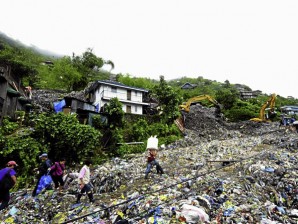
Students, employees and traders climb a mound of 38-year-old garbage, estimated to be 18,000 cubic meters that now occupies Kilometer 5 of Asin Road in Baguio City. INQUIRER FILE PHOTO
MANILA, Philippines—Waste and pollution watchdog urged national and local government agencies to conduct inspection and assessment of waste disposal facilities in their respective areas of jurisdiction following torrential rains in many parts of Luzon that may have caused damage to facilities.
The EcoWaste Coalition specifically directed the proposal to the Department of Environment and Natural Resources, the National Solid Waste Management Commission, the National Disaster Risk Reduction and Management Council and local government units hosting garbage transfer stations, dumpsites or landfills to fully assess the physical conditions of the facilities amid the inclement weather.
The group said the inspection is “crucial” as it is possible that the garbage disposal facilities were damaged “as they are prone to flooding, soil erosion, leachate spillage, ‘garbageslide’ and other health and environmental hazards as we have seen in the past,” EcoWaste Coalition coordinator Edwin Alejo said.
“It is possible that the monsoon rains may have softened the soil and caused undetected damage to the facilities, particularly the retention walls of dumpsites and landfills,” he said.
Alejo recalled that the Payatas dumpsite tragedy in Quezon City on July 10, 2000, occurred after days of nonstop rains, which triggered a 50 foot wall of trash to collapse and bury hundreds of people alive.
In August 2011, on the other hand, Alejo said heavy rains caused the retaining wall of the Irisan dumpsite in Baguio City to slide, causing deaths to five persons.
“As the health and safety of the people and the environment is at stake here, we propose that such inspection be conducted in an open and transparent manner involving residents, barangay [village] officials and civil society representatives,” he said, adding that the public has the right to know. Among the dumpsites and landfills located in “environmentally critical areas” are the Pier 18 Garbage Station in Tondo, Manila; and dumpsites and/or landfills in Payatas, Quezon City, in Antipolo City, Rodriguez and San Mateo, Rizal, in Tanza, Navotas City, in Norzagaray and San Jose del Monte City, Bulacan, and even the one being constructed in Salambao, Obando, Bulacan, the group said.
But as the group said that site inspection is “necessary,” EcoWaste Coalition pointed out that garbage disposal facilities, including the so-called engineered landfills, “can never be entirely safe even with the most expensive liners and pollution mitigation measures.”
The group echoed a warning by experts that “today’s state-of-the-art landfills are expected to be threats to groundwater quality for hundreds to thousands of years after closure.”
Instead of being fixated with garbage disposal through landfills or incinerators, the EcoWaste Coalition proposed investments on effective programs that will prevent and reduce waste volume and toxicity, including clean production, product redesign, toxics use reduction, reduced packaging, eco-friendly consumption, segregation at source, reuse, recycling and composting.
“This will require the honest-to-goodness enforcement of Republic Act 9003, the Ecological Solid Waste Management Act, including the closure, cleanup and rehabilitation of dumpsites and their replacements with community-driven materials recovery facilities or ecology centers,” the group said.